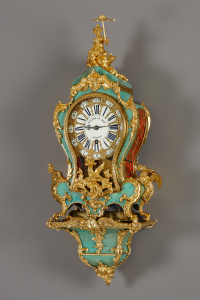French Louis XV console clock, Baillon
French Louis XV console clock, Baillon
Movement
The fourteen-day movement is driven by a spring barrel. It is regulated by an anchor escapement in combination with a pendulum hung on silk. The movement has a pull quarter repeat with two hammers on a single bell. The movement is signed upon the rear plate: J.Bte Baillon AParis, no 4153.
Dial
The white enamelled dial features blue Roman numerals for the hours and an outer ring indicating the minutes in black Arabic numerals. Between the Roman hour numerals are gilt paillons in the shape of French lilies. The openwork hour and minute hands are gilt bronze. The clock is signed in the centre: Jn BAPTISTE BAILLON.
Case
The pronouncedly concave oak case has been glued with tortoiseshell, which in turn has been inlaid with brass floral motifs using the Boulle technique. The case is mounted with fire-gilt bronze ornaments in typical rocaille style. The tops of the clock’s rocaille-shaped legs transform into roaring dragons that direct the viewer’s attention towards the central decoration, which comprises two small angels. One of the angels is asleep, while the other tries to wake him with a bell. They appear to be borne by an owl with outspread wings. The clock’s hood takes the shape of a young child holding a winged hourglass in one hand and a globe in the other. He is borne by two firebirds. All of these decorations fit into the iconographic themes of time and the day and night cycle.
The clock stands upon a separate console that mimics the clock’s decorative scheme.
Baillon
Jean-Baptiste Baillon III (d. 1772) was one of the most skilled and innovative makers of his day. A large part of his success was due to his competence in setting up a large and flourishing private factory in Saint-Germain-en-Laye – a factory that was unique in the eighteenth-century clockmaking world. Baillon's father, the Parisian maître Jean-Baptiste II (d. 1757), and his grandfather Jean-Baptiste I from Rouen were both clockmakers, as was his own son, Jean-Baptiste IV Baillon (1752 - ca. 1773). Baillon himself was admitted to the guild as maître-horloger.
Some of the bronzes are marked C Couronné. An edict dating 1745 required craftsmen to employ a mark on any alloy containing copper in the form of a distinctive lower case letter C surmounted by a crown. The “C Couronné” poinçon, also known as “C coronata” had to be applied to objects as well as furniture embellished or mounted with bronze elements.
The crowned C-mark, measuring just a few millimetres, had long been a much-debated issue for researchers- was it the signature of the bronzier Caffieri, that of the fondeur Colson, or the stamp of the furnituremaker Cressent?
It was not until 1924 that Henri Nocq, in his thesis Le Poinçon de Paris, identified it as a tax mark for bronze objects and fragments that was sanctioned between 1745 and 1749. As with any new tax, this one was very unpopular, triggering many artisans to formally contest the decision in lawsuits against the state. Nonetheless, the edict was formalised in February 1745 and became applicable to “all existent and new works of bronze, pure copper, cast iron, mixed copper, wrought-, ground-, hammered- planed-, engraved- gilded, silver or coloured- no exception.”
Every craftsman was required to report to the hall-mark office at the "cul-de-sac des Bourdonnais" in the Halles district, have his work stamped and pay the royalty fee. It was no coincidence that this all took place during the War of the Austrian Succession and that the military needs were urgent at the time. When the Treaty of Aix-la-Chapelle was signed in February 1749 and financing the king’s campaigns was no longer necessary, the "abolition of small new taxes" followed shortly.
Since the poinçon was obligatory for all metalwork containing copper, sold or exported, between March 1745 and February 1749, one can easily stumble upon the tax mark on pieces dating prior to 1745. For instance, if they received a new layer of gilding or if the objects were brought onto the market during these years. This is also the case with several pieces of furniture by André-Charles Boulle from the Louis XIV period.
- Provenance
- Crijns & Stender, TEFAF 1993
Private collection, Amsterdam - Period
- ca. 1745
- Material
- gilt bronze, tortoise, brass and enameled dial
- Signature
- Jn BAPTISTE BAILLON
- Dimensions
- 75 x 33 x 17 cm
Global shipping available











